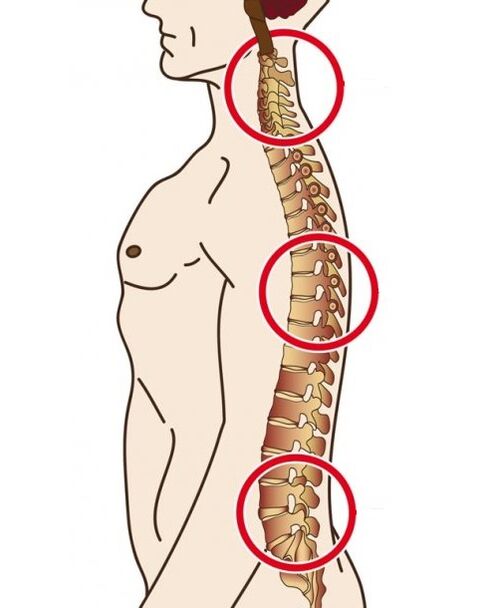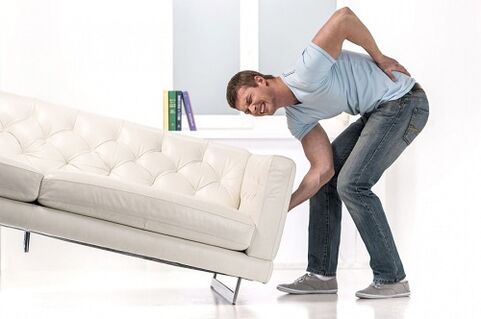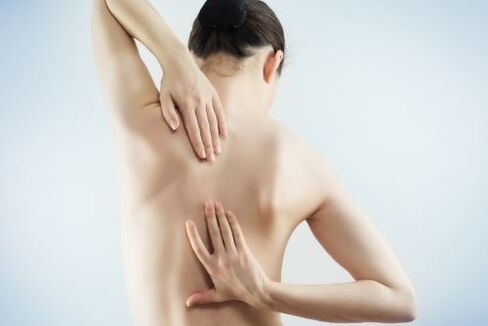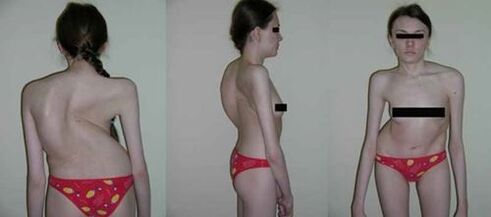What is this disease, osteochondrosis?The definition of the disease can be defined as a degenerative cartilage lesion on the intervertebral discs with further spread to the bone.The causes of osteochondrosis are completely different, but most often they become injuries, a lifestyle without movement, work in one position.However, osteochondrosis on the nerve basis is not excluded.
The appearance of the disease is that it can appear in any part of the human body motor system, and its provocateur can be a neurosis.People have different forms of osteochondrosis of the spine.In general, in medicine, this term is common to imply a set of degenerative dystrophic processes that are localized in the intervertebral discs, as well as small spinal column and vertebrae itself.
Osteochondrosis: What is it?Types of osteochondrosis
What is osteochondrosis?- In medical science, the following types of osteochondrosis are distinguished:
- cervix;
- chest;
- Lumbar

The name of the disease depends on the site of localization of pathological processes.
Basically, osteochondrosis is suffered by people of advanced age.But in recent decades, incidence is increasingly found in people at a young age.
Why does osteochondrosis appear in young?This is largely due to the fact that children do not receive proper physical training.Also, the causes of osteochondrosis can be explained by excessive body weight, which is often observed in adolescents.Statistics say that today every eight person has back disease.
A big problem is that many children spend their entire time sitting on the computer, playing stationary games.Moreover, many professions today are associated with sitting work.And this affects the behavior unchanged, weakens the muscles, which leads to other negative consequences.Indeed, a limited lifestyle in motion and physical activity is a direct way to back diseases.
How does osteochondrosis appear?
There are such unique ones that claim that osteochondrosis does not exist.But at the same time, it is worth noting that such a pathology is associated with a violation of the trophism of the intervertebral discs, which inevitably leads to deformity of clothes.This fact cannot be denied in any way.Therefore, to ignore the disease, and even more to say that it does not exist is visible meaningless.
What is osteochondrosis?This is when, due to degeneration, the discs lose their movement.At the same time, the gaps between the vertebrae are reduced, and this segment begins to lose stability, from which osteochondrosis occurs.A change in the distance between the vertebrae provokes the pinch of nerve endings.As a result, this affects the tension of the back muscles.Later, the pain begins to appear, against the background of which a neurosis occurs.
Changes in a dystrophic nature in discs with osteochondrosis weaken the outer fibrous ring.In this regard, patients can appear in extension and hernia.Further, the devastating progression of the disease passes through the joints, the intervertebral ligaments, which leads to the formation of bone growth in the beads.
Osteochondrosis can contribute to the fact that the patient will suffer difficulties when bending the body, which is associated with the loss of spinal elasticity.Here there is an innate subluxion of vertebrae along with the pathological deformities of the affected areas on the back.All this leads to the fact that a person develops chronic osteochondrosis.

Erosive osteochondrosis
Sometimes patients have a rapid form of processing of intervertebral discs, which was determined by erosive osteochondrosis.This form of the disease is characterized by much more pronounced symptoms, while the patient often has a doubt of spondylodiscite.The main criterion for the diagnosis for the identification of erosive osteochondrosis is the storage of sclerosis of the terminal, which can only be traced by using an X -Ray or CT.
Osteochondrosis: symptoms and causal bonds
Spinal osteochondrosis appears for the following reasons:
- excess loads on the back;
- overweight;
- hard physical work;
- Sitting or standing work;
- the use of unpleasant shoes;
- improper behavior;
- a stationary lifestyle;
- genetic and acquired deformities on the back;
- flat feet;
- genetic predisposition;
- metabolic disorders;
- body intoxication;
- nerve overload;
- stressful situations;
- Severe somatic diseases;
- hormonal violations;
- Autoimmune diseases;
- damage transferred to the back;
- a diet with a lack of minerals and vitamins;
- Harmful habit of health;
- Using unpleasant sleep accessories for night rest.

It is impossible not to say that professional athletes can also undergo increased loads on their backs, which, of course, can lead to the development of posterior diseases.Moreover, they should not severely limit their training number, as it is during this period that the risk of osteochondrosis is the largest.
At its core, osteochondrosis is a glorious disease.Patients constantly feel the periods of worsening disease and forgiveness.An increase in physical exercise, excessive work, as well as hypothermia can lead to intense pain.
If we talk about cervical spine lesions, it is worth noting that patients suffer from neck pain, upper extremities, which may be associated with rigidity in motion, numbness of the fingers and headaches.Along with this, vertebral artery pins can be observed, which leads to an increase in blood pressure, a lack of oxygen consumption in the brain.
With thoracic osteochondrosis, the patient may feel pain or, on the contrary, acute pain, which can be expressed as an interlopter "stake in the back".Pain syndrome can be felt in the heart and lungs and other organs, a patient may also have difficulty breathing, in addition, a weak and severe right -wing syndrome, which is sometimes diagnosed.
The gastralgic form of osteochondrosis of the thoracic region is associated with a cardiac syndrome when the patient feels stiffness in the chest, lungs and heart.In this case, the pain syndrome can intensify during deep breathing.With the further development of gastralgic syndrome, the pain moves in the stomach area, which is fraught with the development of gastritis.

With osteochondrosis of the lumbar region, the pain most commonly appears in the lower back, sacrum and lower extremities.The feelings of the duo can be intense in motion, shots on the back and numbness of the feet is possible.Disruptions in the functions of the organs of the genitourinary system are not excluded.
Among other things, the patient may have dysplastic spinal osteochondrosis.This form of the disease is associated with the formation of growth in the vertebrae along with the pathological deformities of the spinal column.
In patients with osteochondrosis of the lumbar region, so -called visceral syndrome may be observed.At the same time, pain in the affected area gives the internal organs, and a person may think that, for example, the kidneys are injured.
Does what does polysegrative osteochondrosis mean?
In a pathology immediately observed in some segments or covering the entire spine, the patient is diagnosed with polysegent osteochondrosis.The affected segments can be located directly one another, either through one, or even in certain sections of the spinal column.Of course, in such a situation, a comprehensive special treatment is required, which should include not only taking tablets but also physiotherapeutic procedures.
Osteochondrosis and the causes of the disease of a type of polysegmentary are a much more severe disease than it may seem at first glance.If the proper treatment is not performed, then this condition can lead to complete spine stationary.The other photo shows how serious osteochondrosis can be.

Osteochondrosis and vegetative-vascular dystonia (VSD)
Pathological degenerative processes can exist and progress for a long time, until they are completely lost by a person, the opportunity to move.Therefore, if you find at least one sign of osteochondrosis, go to the hospital immediately.
Since pathological deformities in the intervertebral discs are often associated with irritation of the vegetative joints, the disease can cause neurosis, as well as a variety of disorders in the work of the cardiovascular system.Indeed, one of these consequences is vegeter-vascular dystonia.
The main features of VVD include:
- unexpected pressure jumps;
- headache;
- nausea with vomiting;
- insomnia;
- dyspne;
- sweating;
- A constant feeling of excessive work.
Sometimes in a severe form of VSD, a person may lose consciousness.
The appearance of the above symptoms can be a consequence of not only spinal cord damage but also impaired functioning of endocrine and somatic systems.Therefore, only a specialist can make the right diagnosis and choose the right treatment after the relevant examinations.
The treatment of osteochondrosis
Treatment of degenerative processes in the back always means a very long course of therapy based on the integrated use of various medicines and physiotherapeutic procedures.If you have a neurosis with osteochondrosis, be sure to contact a neurologist.The choice of optimal techniques and medicines is only possible after a thorough examination of the patient and various studies.
The doctor can prescribe a restrictive diet, implementing physiotherapy exercises, it is sometimes appropriate to use popular methods.However, any measure should only be taken taking into account the current condition of the patient, the presence of complications and simultaneous diseases, such as neurosis, VSD, increased blood pressure, etc.
One of the main conditions for the successful treatment of osteochondrosis is a sequence.With an irritation of the disease, of course, the first thing you will need to remove the pain syndrome.Further, work should be done to suspend destructive processes.

In the treatment of osteochondrosis, physiotherapy exercises, massage (including self -massage), manual therapy, acupuncture, hydrotherapy and the like are used.Regarding the use of medicines, their main effect should be aimed at eliminating pain, restoring cartilage and normalizing blood circulation in areas affected by the disease.
Most often, patients are prescribed:
- analgesic effects (non -steroidal anti -inflammatory drugs);
- muscle relaxants;
- funds for local anesthesia (compresses, blockade, patch and the like);
- chondroprotectors;
- complexes of vitamins and minerals;
- vasodilating drugs;
- Medicines for normalizing metabolism processes in tissues.
Physical media education on osteochondrosis plays an extraordinary role.Specially selected for a particular patient, the training will help it strengthen the muscles in the back, allow you to form a muscular corset to provide uniform distribution of loads on the back.Due to constant training, blood flow to intervertebral discs will improve.A person will adjust the behavior and make the spine.
There is also a special complex of respiratory exercises that allow you to relieve muscle spasm and pain syndrome.It is good enough to get involved in swimming - it is able to download the spine as much as possible.

When performing exercise therapy, it is important to use special simulators for rehabilitation.It is worth noting that any physical activity is contraindicated during the irritation of the disease.But during the prayer period, they must necessarily supplement medication therapy.
Prevention of osteochondrosis
To prevent the appearance of osteochondrosis, a person must, first of all, maximize the daily load on the back.You need this:
- Choose high quality comfortable socks;
- Avoid a long stay in an unpleasant position, a sitting position or standing;
- Monitor your weight;
- Control attitude;
- Do not freeze excessive severity unnecessarily;
- Commit to charging to strengthen the spinal muscles.
Osteochondrosis is a disease that has very serious consequences.And absolutely everything about osteochondrosis is impossible to know.

























